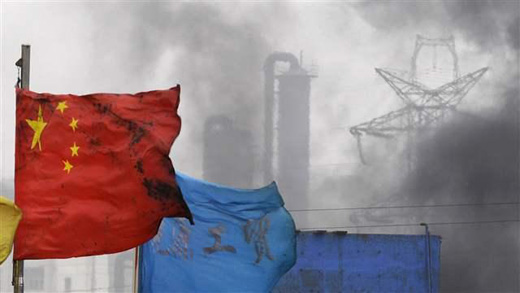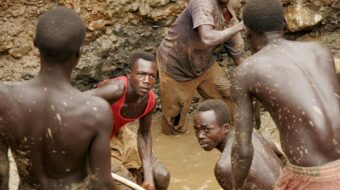
At the debt-laden Longmay coal company in China’s northeastern Heilongjiang province, thousands of workers hit the streets last week demanding back pay and to protest against wage cuts and the possibility that many of them will soon be out of a job.
Last fall, this state-owned firm announced that up to 100,000 workers out of a staff of 240,000 may face the ax. That was bad enough. But when the local governor brazenly told the national media that no unpaid wages were owed at Longmay, the same company where 21 miners lost their lives in a fire in the pits last November, workers and their families refused to go quietly to the unemployment lines. Photos circulating from the Hong Kong press showed thousands marching through the city of Shuangyashan, some of them carrying banners reading, “We want to live, we want to eat!”
The situation in Heilongjiang is not a unique one. Some officials are telling reporters off the record that as many 5-6 million state workers may lose their jobs in the near future as the government scales back so-called “zombie” industries, like coal and steel, which have been on life support for years. The trouble at Longmay is just one example of the problems confronting the Chinese government as it begins the transition away from a low-value manufacturing and export-led model toward a more diversified and consumer-driven economy.
Labor retrenchment and industrial restructuring are always difficult processes in any country, but in China, the prospect of putting millions out of work – especially at state-owned firms – takes on added gravity.
The Communist Party of China (CPC) continues to proclaim its status as the “vanguard” of the Chinese working class and the guarantor of the socialist system, but as the ruling party, it also carries responsibility for laying off these millions of workers. As the country approaches the 40th anniversary of its move toward a market economy, the CPC now has the delicate task of forging a more sustainable model without leaving millions behind.
The legislature, the National People’s Congress, just voted last week to approve a new five-year plan covering the period 2016 to 2020. With the country facing its slowest growth rate in 25 years, however, the plan is unveiled at a time when many around the world are wondering if the Chinese economic miracle is in trouble.
Much fretting has gone on in recent months over the country’s slowdown and its flirtation with the so-called “middle income trap,” whereby reduced injections of cheap labor from the countryside combine with urban workers’ demands for higher living standards to put a squeeze on rapid economic expansion. Credible rumors of a real estate bubble and last year’s stock market instability have only added to concerns that China may be losing steam.
There are good reasons to worry. Given the central place China occupies in the world economy (the IMF estimates the country will account for 18 percent of global economic activity within four years’ time), what happens there has the potential to impact the whole world.
However, it is also important to remember that while the current economic headwinds facing China may be nerve-racking for market watchers, it is not as if they were totally unforeseen. Deng Xiaoping, who pioneered the turn away from Maoism and the centrally-planned economy in the late 1970s, advised policymakers that it would take 30 to 50 years for the country to approach the level of the developed countries. When that happened, new challenges distinct from the early days of reform would emerge.
While the threat of the middle income trap may be exaggerated in the Chinese case, given the huge reserves of rural labor still to be tapped, it would appear the country is indeed reaching the point where its leaders have to start thinking about what the next phase of economic reform will look like.
What’s in the new five-year plan
First off, it’s important to keep in mind that contemporary five-year plans are not the same micromanaged blueprints of production quotas and resource allocations that they were in the past. As Yan Yilong, a professor at Tsinghua University has said, today’s plans focus on formulating broad macroeconomic targets and forecasts “concerning people’s livelihoods and public affairs.” They play a supplementary role to the market in determining production and guiding social development.
Aiming for “medium-high growth,” the plan sets a target of 6.5 percent annually from now through 2020. According to Chinese President Xi Jinping, this will be achieved through a process of reducing industrial overcapacity, restructuring legacy industries, and shifting firmly in the direction of an innovation-driven economy.
The contribution of scientific and technological advances to growth is expected to top 60 percent, with major gains in areas including semiconductors, chip materials, robotics, aviation, and satellite communications. Financial markets will see further opening to the outside world, though full liberalization is not yet being pursued. Planners expect all of these, along with improvements to the public health and social services systems, to be the main drivers of new job creation.
In the area of environmental protection, strict water management and real-time pollution monitoring systems are in development, electric vehicle production is slated for promotion, and a new forest protection plan will ban commercial deforestation and increase land conservation.
The government forecasts the final elimination of poverty by 2020 with the lifting of the last 70 million people who still live below the poverty line of 2,300 yuan, or $376 USD per year. A host of rural infrastructure projects are in the works, as is a stronger social safety net for the elderly, women, and children left behind in the villages when breadwinners seek work in the city.
Reflecting this need for less labor in rural areas, further urbanization is encouraged, and officials are instructed to graft the millions of migrant laborers already living illegally in cities into the official residential registration system, or “hukou.”
And finally on the social front, with an aging population, the controversial one-child policy is being eliminated in favor of a new two-child allowance, and a progressive raising of the retirement age is set to begin.
Unexpected weakness, planned transition, or somewhere in-between?
The realization of all these targets depends, of course, on the maintenance of a strong economic base. And with growth rates retreating, it is reasonable to ask whether such lofty ambitions are realistic. The whole concept of economic planning itself comes into question, for instance, if it was unable to foresee current challenges like the mass layoffs in Heilongjiang.
The transition toward greater reliance on the service and high-tech sectors and the reduced importance of natural resource extraction and low-value manufacturing, however, is not being forced on China unexpectedly. Indeed, while much of the world has been content to continue seeing China as its workshop, it has long been part of the CPC’s overall plan to move up the technology and income ladder.
As for the slower growth rates, they should really come as no surprise. First, there is the issue of scale. When the economic foundation you start with is as underdeveloped as China’s was in 1978, there is a lot of room for growth. The bigger an economy becomes, though, the harder it is to maintain rapid expansion. The same thing has happened historically to all countries at a certain point in their development.
Nevertheless, it is undeniable that China’s growth deceleration has outpaced expectations. Excess capacity in traditional sectors such as coal, aluminum, steel, and glass has been one of the main drags. The 10 percent average growth rate that held for more than 30 years was not expected to last forever, but the IMF still predicted only a short time ago that China’s growth would clock in at 8 percent at least through 2017. The Chinese government says the number for this year will actually be closer to 6.3 percent. (Keeping this in perspective, though, as The Economist noted a year ago, 7 percent growth in 2015 still equaled more output than did a 14 percent rate in 2007.)
A second way of comprehending the growth challenge in China can be found by turning to a 19th-century European critic, Karl Marx, who had insights into the way capitalist economies function – and for all intents and purposes, that’s exactly what we have in China today. One of the key concepts in Marx’s analysis of capitalism was something he called the organic composition of capital, or OCC. What he meant by this rather opaque phrase is the relationship between the value contributed to a commodity by dead labor (i.e., fixed, or constant, capital such as machinery, materials, and other equipment) and living labor (i.e., current workers’ labor power).
As the amount of dead labor in a particular commodity increases, the rate of profit generated in its production will move in the opposite direction over time. This is because it is living labor – the application of human labor power – that creates new value. Thus, as industries become more capital intensive and the amount of new labor being applied drops, there is a corresponding slowdown in the rate at which profit is created.
In what seems like a paradox, it is competition among capitalists – and China has plenty of them these days – that inevitably pushes this cycle of capital investment forward, even though it results in the shrinking of their profit rates.
In the case of China, Australian political economist Phillip Anthony O’Hara noted several years ago that increased competition since the start of reform has been reducing margins and trimming profit rates across the board. The continual investment in capital raises labor productivity in China, but this in turn means a smaller and smaller proportion of new value is created over time. The resulting productivity gains also tend to drive down prices, meaning less and less surplus value is realized on the market. The increases in production volume made possible by these productivity gains, however, mean it was still possible for China’s GDP to make huge leaps.
This process can only carry on for so long, though. Faced with sagging global demand and tapped-out productivity gains, the rationale for further investment in traditional industrial sectors in China is reaching its horizon. Whether private or state-owned, a drawdown of such firms is to be expected. New opportunities for profit-making are now to be found in services, high-tech, and the manufacturing of higher value chain goods such as those mentioned in the new five-year plan.
So it is not only the well-crafted targets of planners in the CPC that is driving the process of change in China’s economy – it is also the logic of capitalist development itself.
Retrenchment in a “workers’ state”
As the case of the Longmay miners illustrates, the other side to this whole program of technological innovation, of course, is the situation facing workers in the industries being restructured. With redundancies forecast in the millions, the state faces the task of compensating and relocating a labor force bigger than the population of some small countries. $23 billion USD has been allocated to cover these costs over the next few years, but it is expected that even more will be needed.
While such payouts perhaps demonstrate the central government’s commitment to supporting workers through the transition, ongoing corruption at the regional and local levels threatens compensation programs and undermines the credibility of both the party and the state. As the Beijing Youth Daily newspaper said in a recent editorial, “If China witnesses another wave of layoffs [like the 1990s] and authorities fail to provide full support for those affected, economic reforms can hardly be implemented.”
As the country becomes ever more enmeshed in the world capitalist economy, the coming period promises to be a test of the CPC’s continued declarations of fidelity to Marxism and its determination to build what it calls a “socialist market economy.” For a government that still claims to rule on behalf of the working class while also forced to cater to foreign investors, the transition toward a more sustainable economic model is fraught with dangers and contradictions.
How the CPC manages industrial restructuring and the move to a higher value, medium-growth system – or the “new normal” as the party calls it – will greatly impact its legitimacy in the eyes of Chinese workers.
Given the centrality of China to global production and investment, Chinese workers aren’t the only ones who need to be paying attention.
Photo: Brookings.edu












Comments